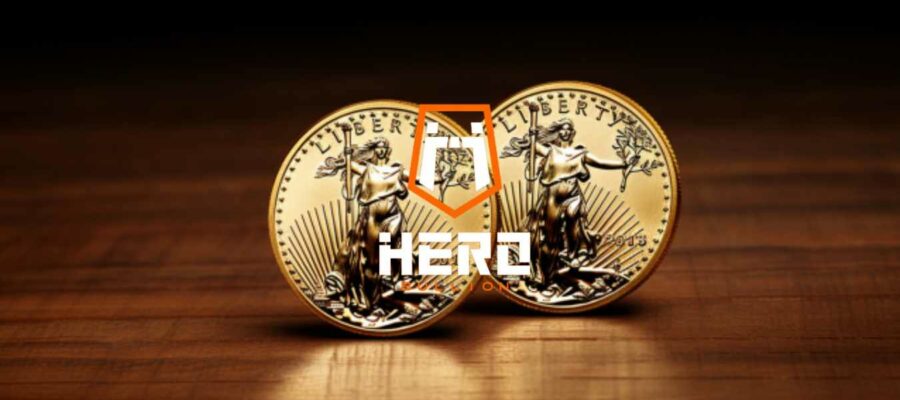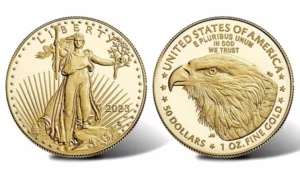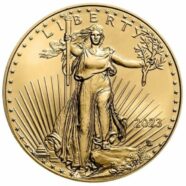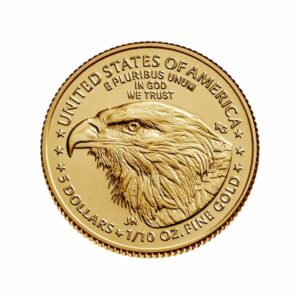50 Dollar Gold Coin

While there are hundreds of gold coins available to stackers, a group of four coins repeatedly dominate the global coin trade. We’re talking, of course, about the Gold Britannia, Canadian Gold Maple, Australian Gold Kangaroo, and the American Gold Eagle. This final coin is the subject of today’s article. Also known as the 50 dollar gold coin, this bullion piece has long been one of the world’s most popular gold coins.
Bearing an obverse depiction of Lady Liberty and reverse artwork of an American bald eagle, the 50 dollar gold coin has always been a favorite for fans of American iconography and symbolism. How much is a 50 dollar gold coin worth? How much gold is in a 50 dollar gold coin? And how can you tell if a $50 gold coin is real? We’re answering all of your questions in today’s Bullion Academy guide!
Historical Background
As an official United States gold bullion coin, the 50 dollar gold coin is equipped with some of the U.S. Mint’s most famous symbols and designs. It was authorized by Congress under their Gold Bullion Coin Act of 1985, which directed the United States Mint to produce a coin including 91.67% gold bullion with a face value of $50 USD. The coin was an immediate success among collectors, and it has sustained popularity for nearly three decades since its initial release.
Minting Beginnings
The 50 dollar gold coin was first released in 1986 after authorization by Congress. Since then, it has become a staple of the U.S. Mint’s regular releases and is circulated once yearly. In 1986, the coin was struck 1,362,650 times. Subsequent releases featured lower mintage numbers, until the U.S. Mint set new records by manufacturing 1,468,530 of the popular gold coins in 1998.
New 50 Dollar Gold Coin Designs
For most of the coin’s lifespan, the 50 dollar gold coin featured a static reverse-side design. Now known as the Type 1 Gold Eagle, the coin showed a family of American bald eagles at their nest. In 2021, mint artist Jennie Norris revealed a revolutionary new form for the reverse of the 50 dollar gold coin. On this modern coin, the reverse depicts a single bald eagle’s portrait. The beak, eyes, and even feathers of America’s national bird are displayed in exceptional detail. This coin is now known as the “Type 2 Gold Eagle.”

Both the Type 1 and Type 1 Gold Eagles include the same obverse artwork. The coins feature Lady Liberty as she walks away from a rising sun. She wears her trademark gown and carries two items: an olive branch and a torch.
Design & Symbolism
The designs included on the 50 dollar gold coin are popular for a couple of reasons. First, the intricacy of these bullion pieces puts the artistry of the U.S. Mint on full display. Equipped with exceptional levels of detail and texture, the coins are popular partially because of their beautiful artwork. Perhaps even more importantly, the coins feature imagery that emphasizes the history and culture of the United States. We’ll take a closer look at the 50 dollar gold coin’s iconic portraits and symbols below.
Iconic Portraits
The “Walking Liberty” artwork on the obverse of the 50 dollar gold coin is actually not entirely unique to this particular coin. It’s a modern adaptation of Augustus Saint-Gaudens’ design, which was used on the original American Double Eagle Coin. This coin remains a popular numismatic rare coin for collectors, and the appearance of Lady Liberty’s design helps to bring back a classic American coin design.
The reverse of the 50 dollar gold coin, however, is an entirely new invention. The original design for the American Gold Eagle featured a family of bald eagles. The father swoops in to visit his partner and child; he carries a single olive branch. From 2021 onwards, the coin will instead highlight a single American bald eagle in a portrait format. His eye looks forward at the coin’s holder, and each feather on its head is displayed in an unprecedented level of intricacy.
National Symbols
Both Lady Liberty and the American bald eagle represent two of America’s most enduring cultural symbols. The bald eagle itself was named America’s national bird in 1782. Lady Liberty’s story really starts in 1885 with the gifting of the Statue of Liberty to the United States by France. The statue quickly became one of America’s most important symbols of liberty and equality. The female personification of liberty has since become a hallmark of most national coins distributed by the United States Mint.

Cultural Representation
When combined into one coin, Lady Liberty and the bald eagle provide a fascinating look into the culture and spirit of the American people. The eagle tends to represent strength, courage, and resilience. Lady Liberty, as her name suggests, is a bastion for the intensely American concept of freedom, independence, and liberty. Collectors around the world flock to purchase 50 dollar gold coins every year, and not just because of their impressive .9167 gold fineness. The coins represent something more – they expertly epitomize the values and culture of the American people.
Rarity & Collectability
Because of their popularity, 50 dollar gold coins are generally not particularly rare. Modern coins sell for around their value in gold bullion, aside from an additional premium over spot. Some older coins appreciate in value over time, and they sometimes sell for a decent premium over the spot price of gold. Certain Gold Eagles might be worth quite a bit of money, depending on their condition, rarity, and notable striking errors.
Limited Mintage
Coin mintage numbers for the 50 dollar gold coin are variable. Over the nearly three decades of yearly releases, the coins have been distributed in different quantities. While the highest mint numbers came in 1986, 1998, 1999, and 2009, some years featured exceedingly low mintage figures. For example, 2007 only saw 140,016 bullion coins distributed to the public. While low mintage numbers don’t influence the total value of a 50 dollar gold coin all that much, coins from lower mintage years might sell with higher premiums over spot than pieces from other years.
Grading Importance
The grade of a 50 dollar coin is extremely important when determining its value on the market. Because these coins are not initially circulated, any signs of damage or circulation can significantly devalue the coin’s total price. These coins are generally traded almost exclusively in brilliant uncirculated (BU) condition. BU coins contain no visible blemishes, even under 8x magnification. If you want to invest in 50 dollar gold coins, it’s important to look for coins that are in perfect condition.
Rare Variations
Unlike most popular gold products, 50 dollar gold coins are rarely minted with valuable errors. If you come across a 50 dollar gold coin with some sort of minting error, it might be worth sending them to a numismatist for professional evaluation and grading. The rarest 50 dollar gold coins will instead come from years with low mintage figures, such as 2019, 2007, and 1996.
Market Demand
Demand for the 50 dollar gold coin has always been high. Along with other popular pieces from the Royal British Mint, Royal Canadian Mint, and Perth Mint, these coins are a hallmark of gold stacking strategies for thousands of investors around the world. We don’t anticipate that demand for the Gold Eagle will decrease in the next couple of decades. In fact, investor anticipation for the new Type 2 50 dollar gold coin might result in even more investor interest in older 50 dollar gold coins.
Investment & Market
Investing in any gold product is inherently risky. As we’ll explain below, the gold market is particularly volatile. Further complicating the investment outlook for new collectors is the unpredictability of numismatic coins. While the bulk of a 50 dollar gold coin’s value comes from its underlying precious metal content, coin premiums are determined by investor demand, market factors, and several additional elements. Tracking investor interest and gauging demand is a difficult process, and even experienced dealers sometimes struggle to develop a genuine understanding of the process.
Gold Market Dynamics
Gold’s volatility should come as no surprise for collectors who frequent our blog. Gold price swings are relatively common, and a quick price movement could potentially sink the value of an un-diversified portfolio. We recommend that consumers diversify their collections using numismatic gold, silver, and platinum coins to avoid the volatile nature of the gold bullion market.
Numismatic Market Factors
Numismatics also play a role in determining the value of a 50 dollar gold coin. Coins from low mintage years might sell for a higher premium over spot than pieces from years with especially high production numbers. This is, of course, tough to predict. To get a better idea of which coins are selling at a higher price, take a look at online auction sales. While coin pricing guides can be helpful for investors wondering how much a 50 dollar gold coin is worth, auction sales provide us with a more accurate estimate of actual sale figures.
Economic Conditions
Just like with any other gold investment, the value of a 50 dollar gold coin will vary based on general economic conditions. Traditionally, gold prices spike during periods of global economic insecurity. Because gold functions as a counterweight to inflation, bad financial times spell positive price action for gold. The same is true for 50 dollar gold coins, which contain .9167 fine gold bullion.
Collecting & Investing Tips
If you’re interested in buying 50 dollar gold coins for your portfolio, there are a few different things you need to keep in mind. Below, we’ll discuss four main tips to help you buy bullion with confidence. We’re going to take a look at proper research, setting budgets, authenticating coins, and expert appraisal in the next four sections.
Research Thoroughly
Research should always be your best friend when purchasing 50 dollar gold coins. Don’t just take our guide as gospel. You should also take a look at coin pricing guides, auction sites, and other online resources to help bolster your understanding of 50 dollar gold coins. When it comes time to buy, shop around for the best possible price. Since most 50 dollar gold coins are traded in BU condition, your goal should be to get a price as close to spot as possible.
Set Budget Limits
Budgeting is an important part of investment. Whether you’re buying gold bullion or traditional stocks and bonds, you should never spend more money than you’re comfortable losing. A solid investment budget takes into account your cost of living and income. Spending too much money on precious metals is always a risky choice, despite the potential for enormous long-term profits.

Authenticating Coins
Expensive 50 dollar gold coins shouldn’t be graded at home. We recommend sending valuable gold coins to a professional grading service to determine authenticity and gold content. In addition to providing you with peace of mind, the certificate of authenticity that some services offer will make it easier for you to sell your coins later down the line.
Expert Appraisals
While coin guides and auction results can help you figure out how much your 50 dollar gold coin should sell for on the secondary market, expert appraisal can be a valuable tool for people who want to get the most money possible out of their gold products. Some online dealers provide professional appraisal services, which can help you determine the approximate value of your 50 dollar gold coin.
Final Thoughts: 50 Dollar Gold Coins
50 dollar gold coins remain one of the most popular gold investment vehicles in the world. We have no trouble understanding why, either. The coin’s beautiful and culturally significant obverse and reverse designs remain important reminders of America’s people and values. Combine these factors with the .9167 purity of the coin, and you have a piece that allows collectors to invest in both beauty and gold at the same time.
You might also like:
About The Author
Michael Roets
Michael Roets is a writer and journalist for Hero Bullion. His work explores precious metals news, guides, and commentary.
